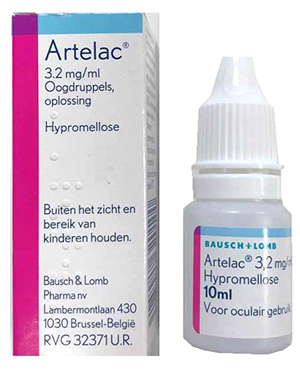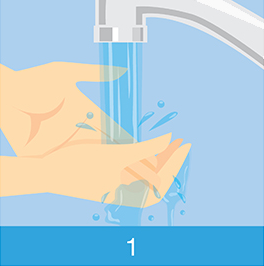
Artelac
The Artelac eye drops are eye moistening drops that combat dry eyes and increase comfort in the eyes. These drops can be administered in case of burning and irritation, as needed.
Here you can read step by step how the implantation of the ICL works. The treatment takes place under local anesthesia on an outpatient basis.
Step 1
Before you enter the operating room, you will receive eye drops (an anesthetic and a drop to make the pupil bigger) from the assistants or from the ophthalmologist himself.
The assistant will also ask if you would like a Valium tablet. Valium is a sedative and relaxes the muscles. This is not mandatory. Just before you enter the operating room, you will be given an overcoat, a cap and you will have to put on slippers over your shoes.
Step 2
In the operating room, you will be given another anesthetic drip.
Step 3
You will lie down on a flat chair. The skin around your eyes will be cleaned and a sterile drape will be taped over the face.
Step 4
After placing the eyelid spreader, the ophthalmologist will first make a small incision at the edge of the cornea. This is the entrance used to place the lens.
Step 5
The artificial lens is rolled up in a holder (cartridge) and inserted into the eye. This is still done through the original 2.5 to 3 mm opening. The lens slowly unfolds and molds to the capsular bag. Once the small lens is securely in place, the rounding process begins. The gel is sucked out of the anterior chamber of the eye. The procedure is complete.
Step 6
You will be taken to a special room where you can recover.
Step 7
You will be explained the drops/medications you will need to use after the procedure. Before you go home, your eyes will be checked. This is about 2 hours after the treatment. The eye pressure will be checked.
How long does the procedure take?
The actual treatment takes about half an hour, in total you will be present for about 3-4 hours. Visus eye clinic works with high quality standards. It is possible that the doctor in charge cancels the procedure on or just before the day of treatment. It will be explained to you why the treatment cannot take place.
After the treatment, you do not have to keep your eyes closed, but you may.
The first hours after the treatment your eyes will tear, you may have a burning sensation or a headache. You may also feel that you cannot keep your eyes open. You may feel that there is something in the eye. These are normal symptoms that usually disappear after about 4 hours. If necessary, you can take a light painkiller like paracetamol.
What you see the first few days is not decisive for the result of the treatment. It is important for a quick recovery of the eye after the treatment that a number of rules are followed:
The first 24 hours you should not shower (the head and hair must remain dry) or bathe. The following days in such a way that no water enters the eye.
Rubbing the eyes should be avoided for at least 6 weeks. Even after that you should be careful not to rub the eyes.
You may bend over, but try to avoid excessive lifting and pressing for the first 2 weeks.
After 2 weeks, you may use makeup again. Be careful with the use of mascara and eye shadow: these should also be removed without rubbing too hard or too much.
You should take the following into account when doing sports:
Do not do strength training for the first 2 weeks.
Do not swim in chlorinated water or seawater for the first two weeks.
Do not use a sunbed for the first 2 weeks, after that it is better to protect your eyes with special glasses.
Avoid hard blows to your eyes. So for ball sports or contact sports protect your eyes for the first two months.
For specific sports or when in doubt, consult your doctor or clinic.
Within a few weeks the intended result of the procedure is achieved, in the meantime you can usually function as normal. With tri/multifocal lenses, habituation often needs to occur, sometimes you may also need to do exercises to get your brain used to the new vision. A positive attitude and awareness that your vision will improve will help you adapt more quickly.
Letter of discharge from your general practitioner
On the day of treatment you will receive a letter of discharge for your general practitioner, together with your medication. You should give this letter to your general practitioner
After the treatment, use drops to speed up recovery. You will receive a number of medicines from us. These medicines are prescribed by the ophthalmologist and declared to your health insurer by the home pharmacy of the clinic. Any personal contribution is the responsibility of the patient. If you are insured abroad, you must pay the costs of the medication to Visus Oogkliniek. You can request a quote at the counter.
For repeat prescriptions you can request your prescription online via the website www.visusoogkliniek.nl under the heading “contact” at the top right. It is therefore important that you know the fax number of your pharmacy.
If your doctor differs from the standard medication described on this page, follow your doctor's advice and ignore this page.

The Artelac eye drops are eye moistening drops that combat dry eyes and increase comfort in the eyes. These drops can be administered in case of burning and irritation, as needed.

Diamox should only be taken on the advice of the doctor. Thanks to the Diamox tablet, the eye pressure is lowered and if there is any oedema (fluid) present it will be drained more easily. You will receive 2 tablets of Diamox as standard on the day of treatment, but only on the doctor’s advice.

You use the Nevanac drop after the first follow-up checkup. The Nevanac drop has an anti-inflammatory effect. From the first follow-up check, you should use this drop once a day for 28 days.

The Tobrex eye drops are used for the prevention of inflammatory symptoms. On day 1 through day 7, use the Tobrex drops twice a day.

Dexamethasone inhibits inflammation and hypersensitivity reactions. You use Dexamethasone on day 1 through day 28 in a tapering schedule.


Follow the next steps:




Geen probleem. Je kunt ten alle tijden de test opnieuw doen om een nieuwe calculatie te starten.